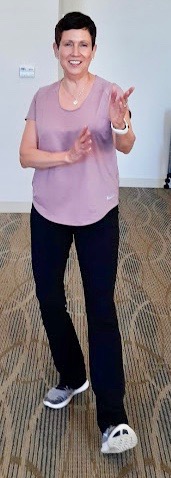By Teddy Robertson
It all began with a New York City police officer.
Michigan-native Gloria Kramer was an accomplished 5K, 10K, and half-marathon runner when she realized she wanted something more than what she got from a good run. Living in Florida where she worked as a registered dietitian, running had been her avocation.
“I was in my thirties,” Kramer says. “Meditation was becoming popular and I was interested, but I had a heck of a time just sitting still and clearing my mind.”
That’s where the policeman came in.
Kramer saw an ad for a tai chi class, and the instructor turned out to be a police officer from New York who’d given up his career to teach tai chi. Gloria learned Yang 24, a “form,” or set of traditional tai chi movements created in China in 1956 to bring the benefits of tai chi to the masses.
“Tai chi is ‘moving meditation,’ she says, “It gives your body and mind a chance to connect. I liked the physicality of it, plus the mental aspect.”
Kramer continued her tai chi instruction with Hilmar Fuchs, a renowned German martial arts master headquartered in Florida. Gloria describes Fuchs as phenomenal teacher; tai chi really “resonated with me,” she says.
She was hooked.
But life happens. Kramer and her family (now including an infant daughter) returned to Michigan. She searched for a teacher, but never found someone equal to Fuchs.

Gloria Kramer (Photo by Teddy Robertson)
Fast forward several years and life intervened once again. Kramer’s daughter turned six and wanted to learn karate. The karate studio offered parents the option of watching their kids’ classes or participating themselves for the same cost. Guess what?
Kramer learned along with her daughter and eventually obtained a second degree Black Belt in Tang Soo Do, Korean-style karate.
“But as I grew older,” she says, “those takedowns and throws are harder on your body.” She returned to tai chi.
At first Kramer practiced qi gong (or chi gong) warm up exercises and tai chi in the evening to help a cousin relieve anxiety during a stressful time in her life. Kramer remembered her cousin’s comment: “You know, you should teach this; you’re really good at it.”
Qi gong involves repetitive exercises to stimulate the flow of qi or energy throughout the body, whereas tai chi involves a “form” or sequence of movements that flow from one to the next that complete an entire set movements.
A registered dietitian with a master’s degree in nutrition, Kramer had always enjoyed the teaching she’d done in hospital settings. Maybe her cousin was right? She should become a teacher herself.
Kramer sought out tai chi instruction online that would prepare her to teach. She began with the program of Vancouver specialist, Dr. Keith Jeffrey, originator of “Easy Tai Chi.” At a weekend session for certification, people told her about Dr. Paul Lam.
A physician and world leader in tai chi for health for over forty years, Dr. Lam has promoted tai chi for health improvement from his home in Australia. https://taichiforhealthinstitute.org/about-dr-paul-lam/ Dr. Lam and his master trainers also teach in the US, annually offering workshops in different states.
Kramer attended a regional workshop in Cincinnati held by Lam’s Tai Chi for Health Institute, and today she is certified in all the Institute’s tai chi forms adapted for different needs: tai chi for health, energy, arthritis, rehab, and diabetes. In week-long intensive courses with Lam’s master trainers, Kramer learned other long forms of tai chi: Sun 73 and Chen 36.
Kramer’s journey toward official teaching began when she offered a class at her karate studio. She went on to teach evening classes for Flushing’s Community Education. Today Kramer teaches a total of 13 tai chi classes a week in four different locations: YMCA Pierson Road, Grand Blanc Senior Center, Woodhaven Assisted Living, and the McLaren Hospitality House Conference Center (cancer patients take these classes for free). Today 80 adults are learning tai chi in these classes.
Tai chi instruction is challenging. For successful learning, beginners, intermediate, and advanced learners must be grouped to accommodate their skill levels. At Grand Blanc and Hospitality House Gloria teaches the three levels back to back.
Kramer emphasizes that you have to experience tai chi to appreciate its value for health and well-being. “People who manage to complete one month or longer are more likely to stay with the practice than those who take a single class.” For example, most of Kramer’s regular students at McLaren Hospitality House have been attending twice a week for three or four years.
To accommodate people who drop in at the Pierson Road “Y,” Kramer usually teaches one tai chi form twice a week and then chi gong exercises the third day of the week. People often begin with the qi gong exercises and then jump into the tai chi class.
Kramer views America as a vast, potential market for tai chi. The variations designed by Dr. Lam and his team show how the practice is adapted for all ages and conditions. Still, “so many people just don’t have access,” she says. One approach is “working though hospitals . . . a wonderful way to get in touch with people who could benefit.” Kramer would like to get doctors interested; she has experimented with teaching tai chi to staff in medical offices. “The market is untapped in many different places,” she says.
An adept practitioner of three tai chi styles—Yang, Sun, and Chen—Kramer describes the benefits of each one. When asked if she has a favorite, she replies: “The Chen 36 is mentally challenging but also athletic, Sun 73 is good for relaxing and breathing, and Yang 24 has a pleasant flow.”
Tai chi is rooted in the ancient Chinese philosophy of yin and yang oppositions. Reflecting on this duality, Kramer notes, “yin is water and yang is fire. Tai chi belongs to the spirit of yin in life. Americans tend to embrace yang-type or active principle movement like aerobic exercise or weightlifting. Everything is so hard and fast. But our minds are very overactive; our life is over stimulated.”
Kramer repeats, “tai chi really needs to be experienced.” While its practice may be hard to explain, the benefits of tai chi are recognized and promoted by the Center for Disease Control, the National Council on Aging, and the Arthritis Foundation.
US medical and healthcare systems, however, are not geared to offer tai chi or qi gong exercises as a prescription—in contrast to countries like Australia and China. “We may eventually embrace tai chi for health,” Kramer says, “but we are a long way away from it.”
Meantime, interest in tai chi grows slowly and Gloria Kramer continues to teach. Asked about her future plans, Kramer muses, “I’ve been thinking that maybe next spring I’ll offer an evening class for working people”—just the audience that might appreciate a bit more yin in their overactive lives.
More information on the practice of tai chi is available at Chi Force Tai Chi @ 810-348-6530.
Banner photo of one of Gloria Kramer’s tai chi classes by Teddy Robertson.
EVM Staff Writer and columnist Teddy Robertson can be reached at teddyrob@umich.edu.


You must be logged in to post a comment.